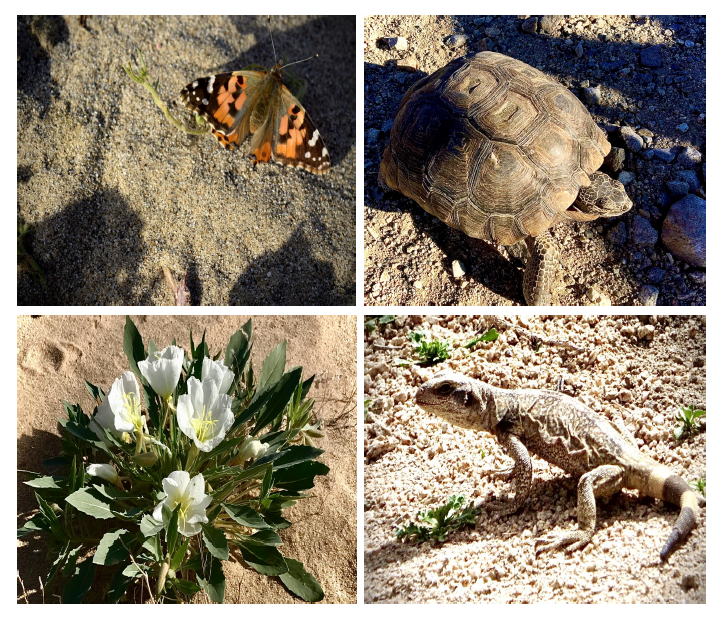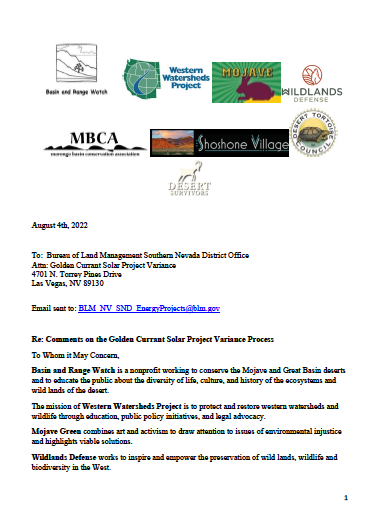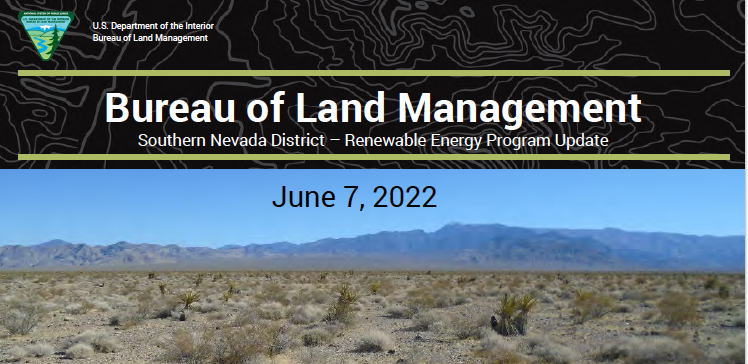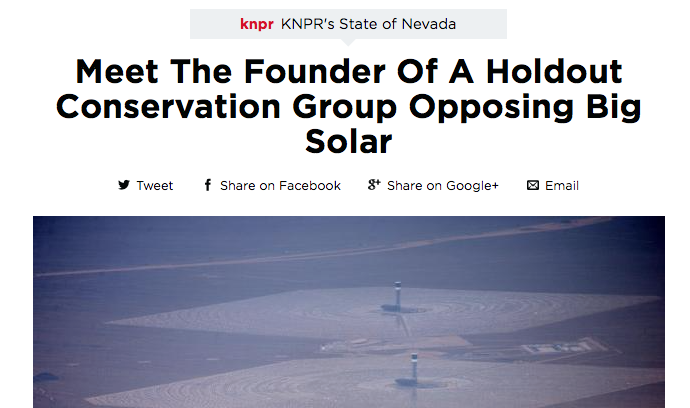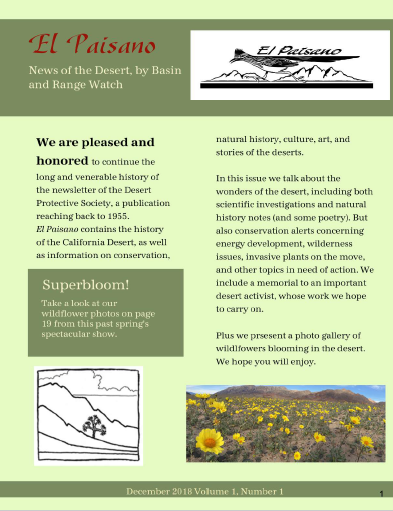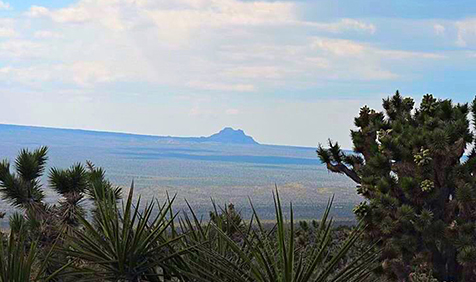
Basin & Range Watch
Defending the Desert
A 501(c)(3) Non-profit organization
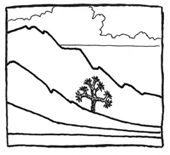
WELCOME
Basin and Range Watch is a 501(c)(3) non-profit working to conserve the deserts of Nevada and California and to educate the public about the diversity of life, culture, and history of the ecosystems and wild lands of the desert.
Come visit and experience the great beauty of spring wildflowers, vast open vistas, bird watching trails, and wildlife viewing.
emailbasinandrange@gmail.com
Are you an academic researcher or news reporter using our website content for your next book, scientific paper, or article? Please give us credit with a reference! Thank you!
![]()
We Are Moving to a New Website: Basin and Range Watch 2!
December 22, 2023 -- The volunteers at Basin and Range Watch are gradually switching to a new website, but we'll keep this one around as an archive since it has so much material.
See the new website here! https://www.basinandrangewatch2.org/home
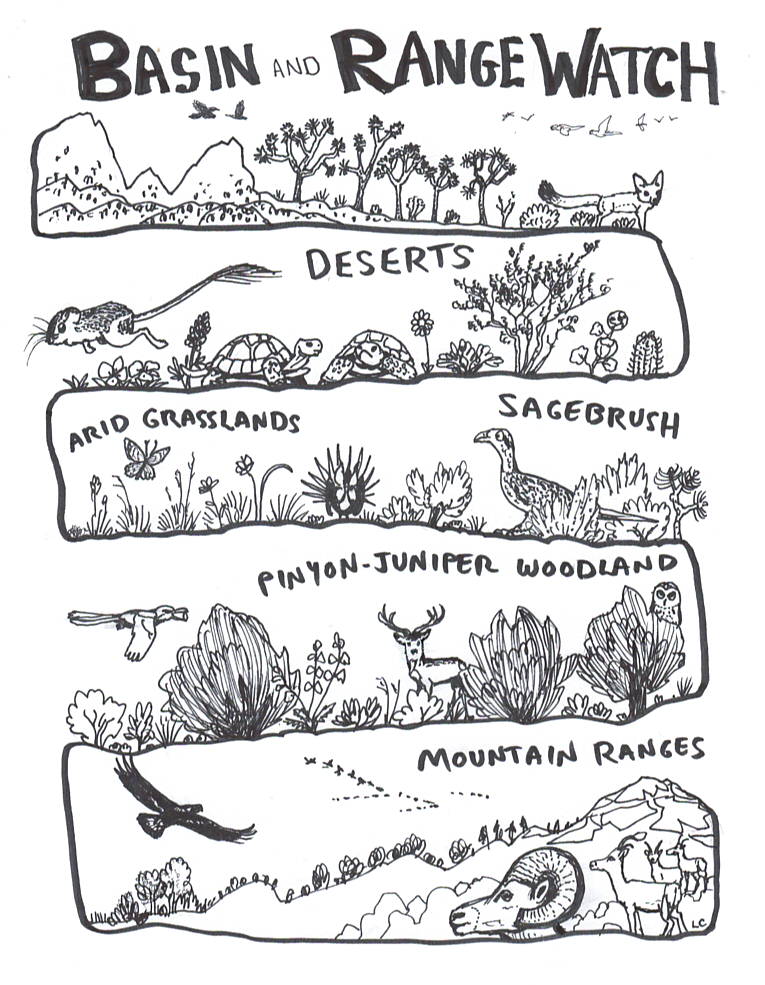
GridLiance West Core Upgrades Transmission Line Project
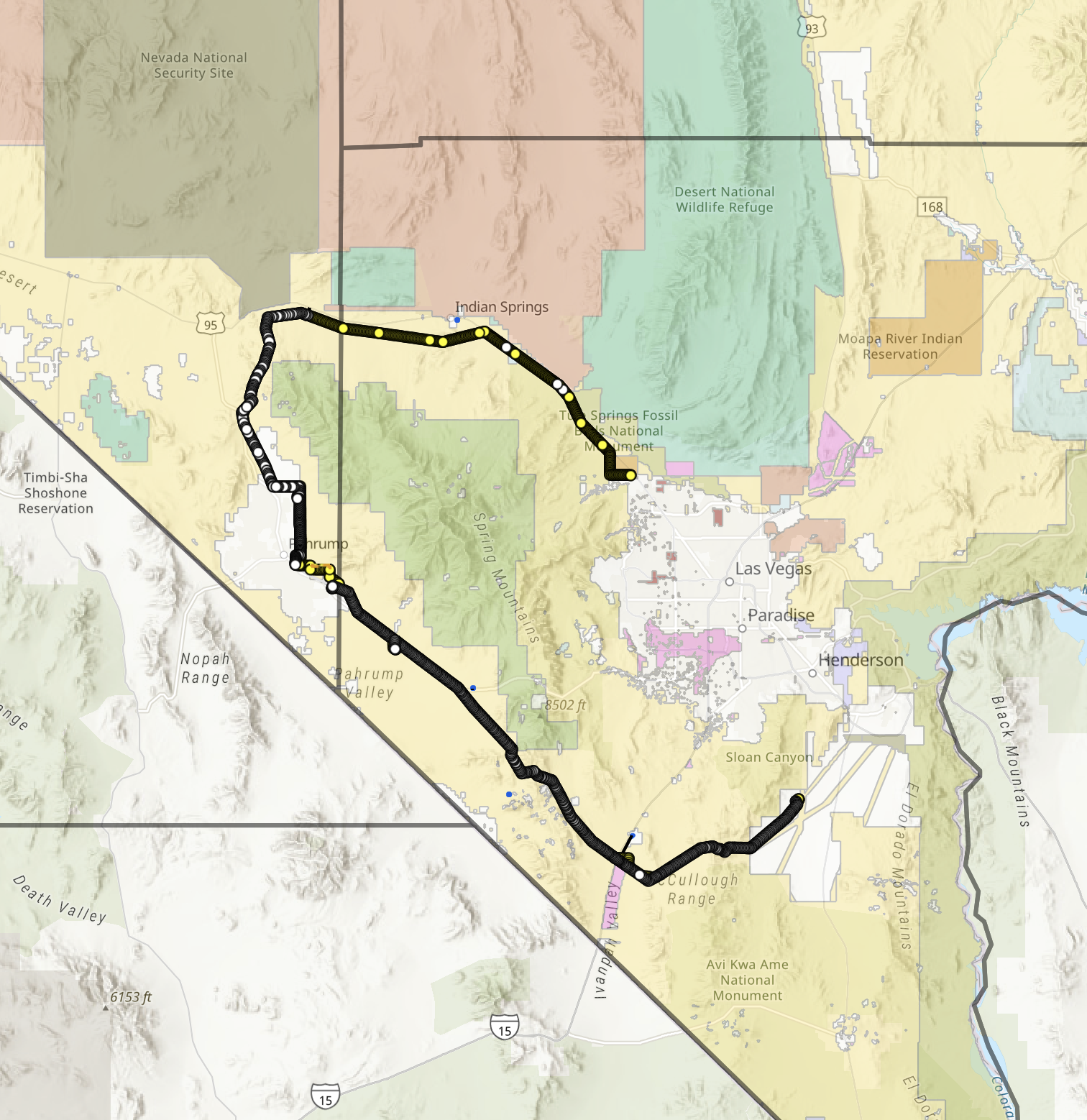
^Map from BLM eplanning.
August 8, 2023 - Nye and Clark Counties, NV - In addition to the proposed massive Greenlink West and North Transmission Projects, the Bureau of Land Management recieved an application to upgrade the existing 155-mile-long 230-kiloVolt GridLiance Transmission Line that wraps around the Spring Range and passes through Pahrump. The upgrades could make the new line 500 kV. The existingline is within the California Independent System Operator grid area, and upgrades would need study by the CAISO as well.
We beleive this upgrade is to be able to take more utility-scale solar projects in Pahrump Valley, Amargosa Valley, and around Indian Springs and elsewhere.
From the Sloan Mountain Substation, several substations would need enlargement and upgrades, including the Trout Canyon Substation, Innovation Substation, Gamebird Substation, Pahrump Substation, and Desert View Substation. A new Johnnie Corner Substation is proposed to be constructed. The line would end at the Northwest Substation.
The Proposed transmission project would take up 4,600 acres of land, with right of way as much as 275 feet wide if a double-circuit 500 kV line is chosen. Poles could be 200 feet tall. The 1998 Las Vegas Resource Management Plan would need to be amended to downgrade Visual Resource Classes in certain areas in order to accomodate this giant upgrade. For more see >>here.
https://public-inspection.federalregister.gov/2023-17060.pdf
https://eplanning.blm.gov/eplanning-ui/project/2025248/510
Written comments will be accepted until September 7, 2023 for scoping an Environmental Impact Statement and associated Resource Plan amendment by the Bureau of Land Management (BLM).
Email: BLM_NV_SNDO_NEPA_Comments@blm.gov
Mail: BLM, Southern Nevada District Office, Attn: GridLinace West Core Upgrades Transmission Line Project, 4701 North Torrey Pines Drive, Las Vegas, NV 89130-2301.
Scoping Meeting Dates/Times and Registration:
August 29, 2023, 6:00-8:00pm Pacific Time
Click to register: https://bit.ly/GridLianceScopingMtg1
August 30, 2023, 6:00-8:00pm Pacific Time
Click to register: https://bit.ly/GridLianceScopingMtg2
Solar Project Applications Pour Into Nevada Outback
August 8, 2023 - Nevada - New large-scale solar project applications are hitting the Nevada Public Utility Commission, in anticipation of possible new high-voltage transmission lines: Greenlink West, Greenlink North, and now a Gridliance upgrade proposal.
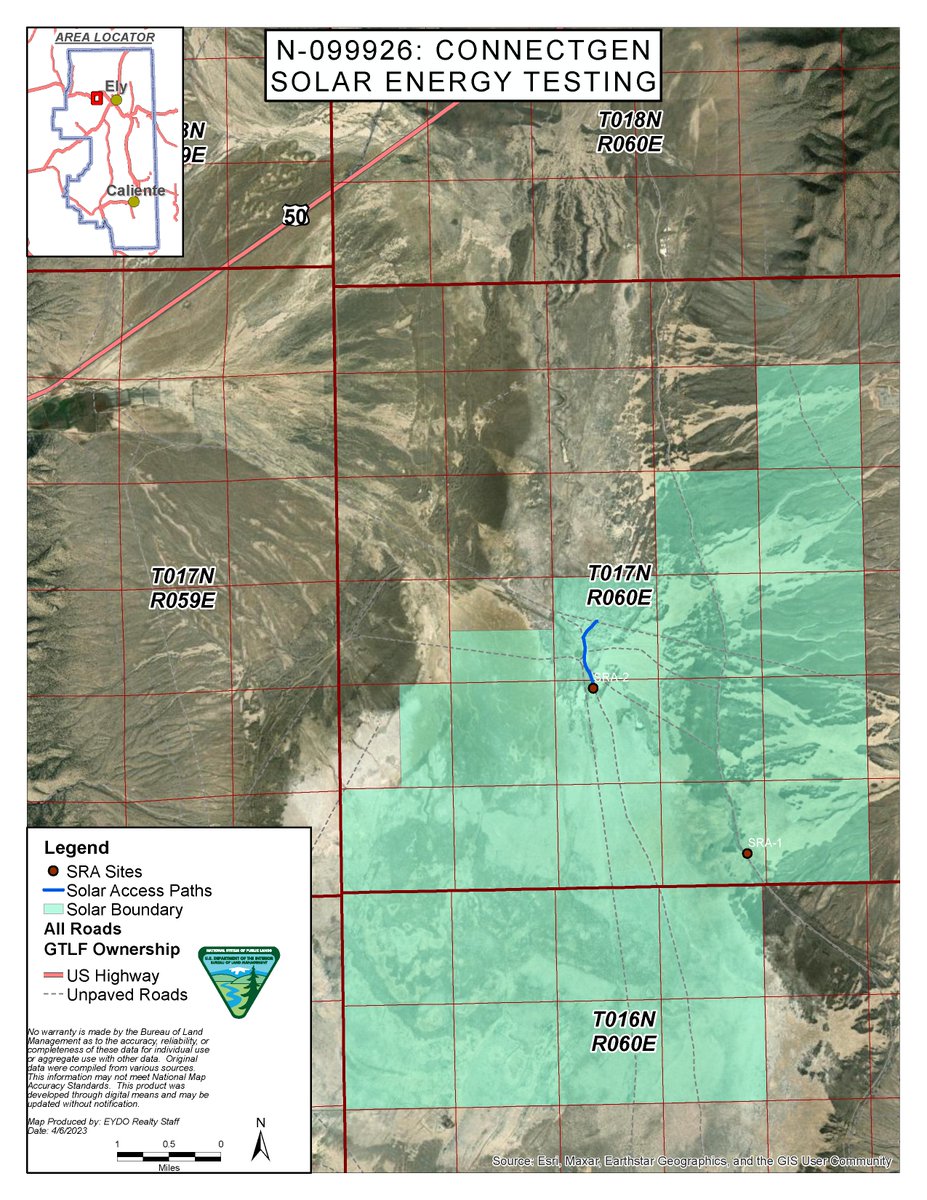
The Robinson Solar Project is a proposed 15,683-acre solar application in Jakes Valley, Nevada, 20 miles from Ely and located in sage grouse habitat - seeking to connect to the proposed Greenlink North Transmission Project. All habitat for the imperiled greater sage grouse is now apparently open to utility-scale solar projects.
https://pucweb1.state.nv.us/PDF/AxImages/DOCKETS_2020_THRU_PRESENT/2023-7/27934.pdf
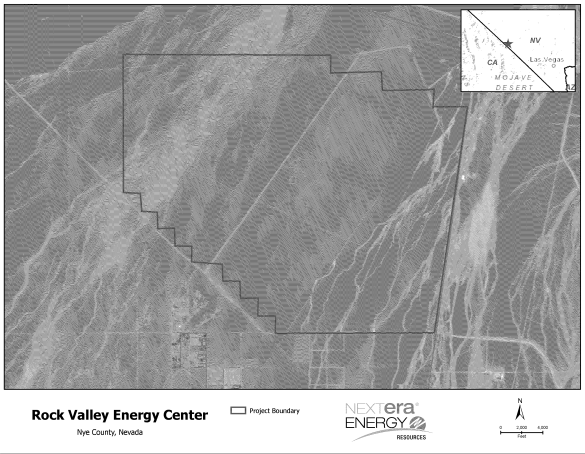
In Amargosa Valley, Rock Valley Solar Energy Center is proposed next to Lathrop Wells, Nevada about 7 miles from Ash Meadows National Wildlife Refuge and Devil's Hole. A project this size would need a one-time construction water use of over 2,000-acre feet. The project is proposed at 10,000 acres, and is on excellent creosote desert habitat with kit foxes and burrowing owls, as well as wildflower displays after rainy winters. Recreational routes cross this area.
In addition, as the above map shows, this project is sited poorly on top of the large acrive wash for the Forty Mile Canyon, which is basically an ephemeral fork of the Amargosa River. After massive and widespread rains in October of 2015, we saw this was flood with a very large amount of water, which flooded the town of Lathrop Wells, and sent a 500-foot-wide river of water into the mainstem of the Amargosa River down to Shoshone, CA, and beyond. We hope the project applicant and Bureau of Land Management seriously consider the surface hydrology in their environmental review.
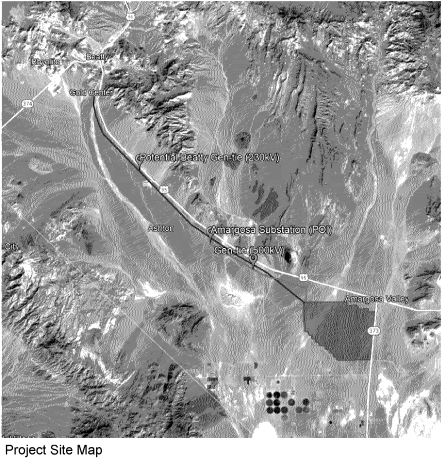
Mojave Literary Journeys #2
[August 3, 2023 - Basin & Range Watch notes that Ruth Nolan's writings and poetry on the Dome Fire are now particularly current as the 94,000-acre York Fire burns through the New York Mountains and northern Lanfair Valley in the Mojave National Preserve, California, and into 8,000 acres of the new Avi Kwa Ame National Monument in adjacent Nevada. The wildfire raced towards Wee Thump Joshua Tree Wilderness Area in Nevada on Sunday, but seems to be mostly contained in this direction as of today--Laura Cunningham.]
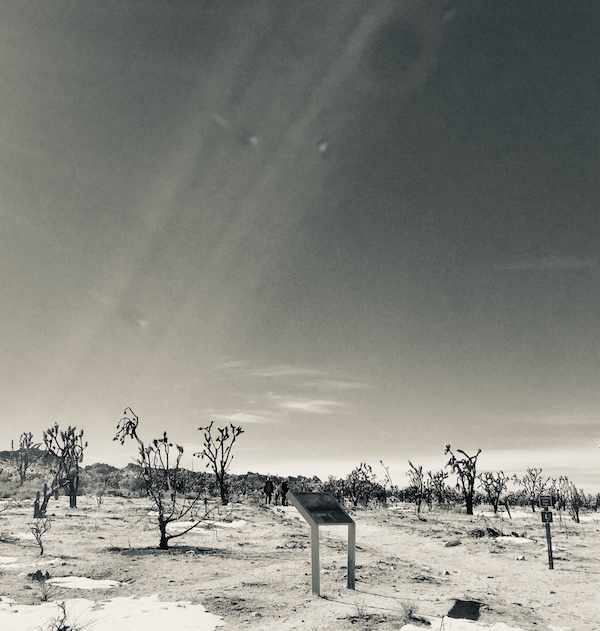
^After the Dome Fire of 2020. This was once the largest Joshua Tree forest in the world. Photo by Ruth Nolan.
Witnessing the Demise of the Mojave Desert to Renewable Energy Industry and Devastating Wildfire, Courtesy of the BLM
by Ruth Nolan, Mojave Desert Poet Laureate
In the late 1980s, I had the privilege of working for the Bureau of Land Management, California Desert District on a wildland fire engine crew and also on the Helicopter 554 hotshot crew, both out of the Apple Valley, CA fire station.
We routinely worked on fire suppression across the huge Mojave Desert where it spreads its majestic, Joshua tree-carpeted swatch across California, Arizona and Nevada. Many fires were sparked by monsoon lightning strikes, and some were started by the carelessness of people. Most were suppressed by us and other BLM crews, such as the one from Hole-In-the-Wall, in remote and scenic wildlands that few are lucky enough to ever venture into due to their extreme remoteness.
Working on a helicopter gave me a close-up view into the integrity of the Mojave Desert's contiguous, mostly-unbroken land flows as it is spelled out in sacred geologic-ecologic eco-tones as one of the world's few remaining such places. And in the late 1980s, as a young adult, I had no idea of the preciousness of this mind-boggling, soul-nourishing place and how quickly and swiftly, just a few decades down the remotest of dirt roads, its demise would be sealed into place.
In the year 2023, I bear witness with heartbreak and dismay as the BLM has established and continues its role as a land broker for the destruction and desecration of many of these wildlands for the construction of large-scale renewable energy projects.
I bear witness as at least one massive wildfire, in the heart of the Mojave Desert at Cima Dome, not far from one of the first massive solar project at Ivanpah in southernmost Nevada, burned 43,500 acres in 2020, devastating what was once the world's largest Joshua tree forest. It took several days for H554 to arrive at Cima Dome, I learned from friends in the fire-suppression community, and without that and other support for critical initial attack intervention - the pandemic of 2020 and lack of fire crews across California was an unfortunate factor -, the region was doomed.
Read more >>here
Construction Photos of Yellow Pine Solar Project
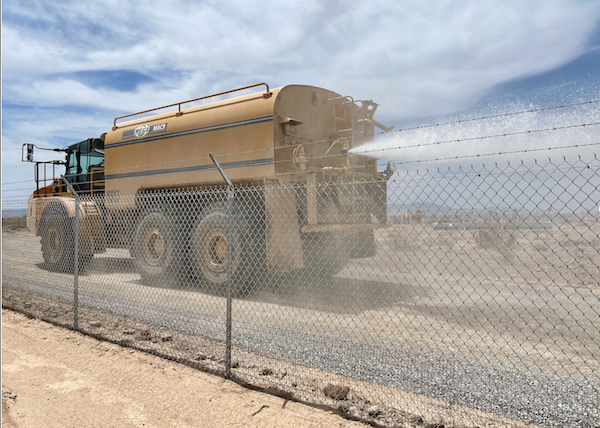
^Water truck at the Yellow Pine Solar Project under construction, for dust suppression.
June 16, 2023 - Pahrump, NV - Various photos of the Yellow Pine Solar Project under construction from 2022 into 2023. More photos >>here.
New Arizona Solar Projects
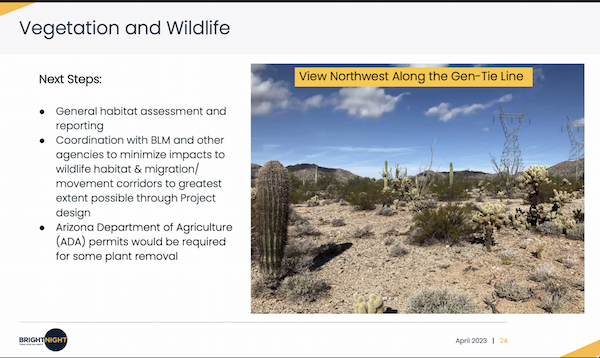
^April 12, 2023 Bureau of Land Management virtual presentation screenshot of the proposed Eagle Eye Solar Project undergoing Variance review. This project would remove saguaro cactus plants from native desert habitat. More project applications are coming in.
June 10, 2023 - Kingman, Arizona — The Bureau of Land Management (BLM) will hold a virtual forum on May 18, 2023, at 5 p.m., to share information and receive public input on three applications for solar energy development on public lands designated as solar variance areas in Mohave County. The three projects are White Hills Solar, Mineral Park Solar, and Leo Solar. White Hills is initially proposed as 450-megawatt on 4,300 acres of public lands, Mineral Park Solar is initially proposed as 275-megawatt on 3,958 acres of public lands, and Leo Solar is initially proposed as 300-megawatt on 3,736 acres of public lands. More >>here.
Proposed Greenlink Transmission Lines Would Industrialize Nevada’s Outback and Harm Wildlife
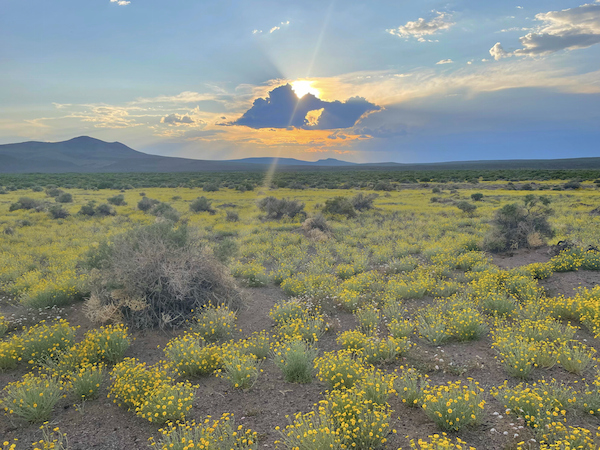
^The upper Amargosa River floodplain covered in woolly baileyas (Baileya pleniradiata) this May. The giant Greenlink West transmission project proposed to cross right about here.
May 30, 2023 - Reno, NV -- The Bureau of Land Management (BLM) has taken the next major step in the environmental review process to advance the construction of 707 miles of two gigantic high-voltage transmission lines in some of Nevada’s most remote, scenic, and biologically significant locations by issuing a Draft Environmental Impact Statement. The Greenlink lines are proposed to be built by the utility NV Energy and would be mostly 525-kilovolt transmission lines that would carry power generated from solar, wind, geothermal, biomass and possibly natural gas generation through wetlands, sage grouse habitat, lands with wilderness characteristics, desert tortoise habitat, pronghorn habitat, culturally significant lands, rare plant habitat, over Joshua tree forests and near tourism-based small communities.
“Both Greenlink projects would open up a Pandora’s Box of large-scale energy impacts in Nevada’s most isolated areas and intact landscapes. These projects would create unacceptable impacts to wildlife, rare plants, cultural resources, small communities, and visual landscapes,” said Kevin Emmerich, Co-founder of Basin and Range Watch. “Instead of celebrating Nevada’s natural and cultural resources and directing green energy to previously disturbed lands, politicians have chosen to industrialize the very landscape that makes our state unique.”
The 471-mile Greenlink West Project is now being reviewed with an Environmental Impact Statement with a 90-day public comment period. The transmission towers would be nearly 200 feet tall starting at the natural gas power plants at the Harry Allen Substation at Apex, near Las Vegas, cross remote areas of wildlife habitat in western Nevada, and finally ending up to mostly supply Lithium battery factories and tech industries in the Reno area. The Greenlink West Project would not only impact lands managed by the BLM, but also National Park Service lands, Tribal lands and reservations, and private lands. More >>here.
Draft Environmental Impact Statement for Greenlink West Transmission Project is Released for Public Comment
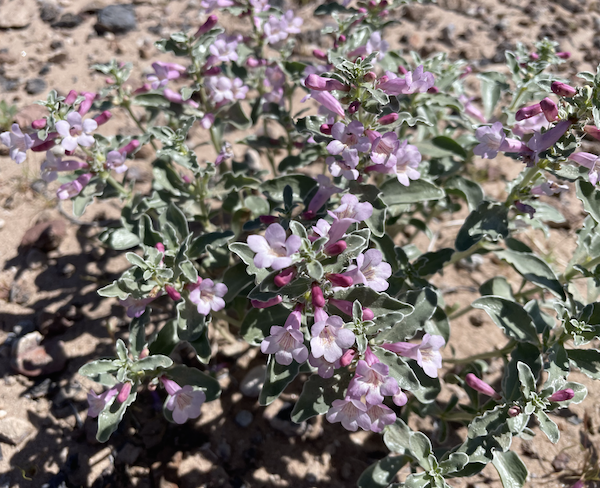
^The rare white-margined penstemon (Penstemon albomarginatus) has populations in sandy areas of the Amargosa Valley, Nevada, directly in the proposed path of the Greenlink West Transmission proposal. Will giant transmission destroy biodiversity in the Mojave Desert?
May 25, 2023 - Nevada - Today the Bureau of Land Management (BLM) released its Notice of Availability of the Draft Environmental Impact Statement (EIS) and Resource Management Plan Amendments for the Greenlink West Project in Clark, Esmeralda, Lyon, Mineral, Nye, Storey, and Washoe Counties, NV on the public inspection page (https://public-inspection.federalregister.gov/2023-11102.pdf) for hard release tomorrow on the Federal Register.
This notice announces the opening of a 90-day comment period for the Draft EIS. We have been preparing for this day, and we adamantly oppose this over-priced natural gas transmission line hooking into Las Vegas area Apex natural gas baseload power plants that will increase rate-payers' monthly bills all to serve mega-factories in the Reno-Sparks region, such as Tesla, Blockchain, and other energy-intensive California-transplant industries invading Nevada. "Green"link is not meant to help rural or native Nevadans lower their electrical bills, but instead boost profit of out-of-state Billionaires. This fossil-fuel high-voltage transmission boondoggle would cost Nevadans increased utility bills across the state. The cleverly named "green" in the project applications' name foold many people, but not us.
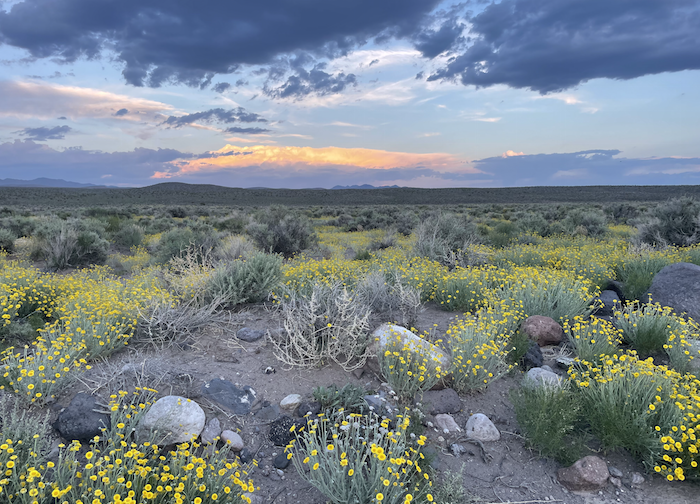
^Greenlink West high-voltage giant transmission project would cross remote and wild deserts in Nye County, Nevada, full of spring wildflowers--here woolly baileya (Baileya pleniradiata).
The BLM will be hosting both virtual and in-person public meetings during the 90-public comment period. The dates and locations of any public meetings will be announced at least 15 days in advance through local media, newspapers, and the BLM website at: https://eplanning.blm.gov/eplanning-ui/project/2017391/510.
See more >>here at our Greenlink page.
Bureau of Land Management Pushes Ahead With Bonanza Solar Project Despite Huge Conflicts
April 27, 2023 - Cactus Springs, NV - Bonanza Solar west of Indian Springs, Nevada is being pushed forward by the Interior Department in one of the most important identified desert tortoise areas in Nevada. We found a large female on the site yesterday, Tragic it may be bulldozed. https://www.blm.gov/press-release/bureau-land-management-begin-nepa-process-bonanza-solar-project-application
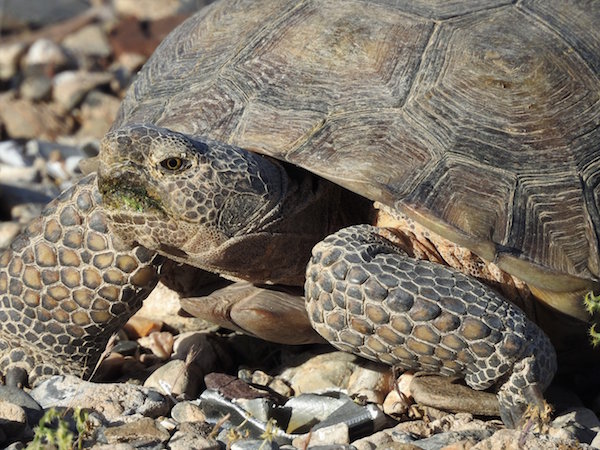
^Healthy adult Mojave desert tortoise on the site of the porposed large-scale solar project north of Cactus Springs, in an intact landscape.
More >>here.
Basin & Range Watch Celebrates the New Avi Kwa Ame National Monument
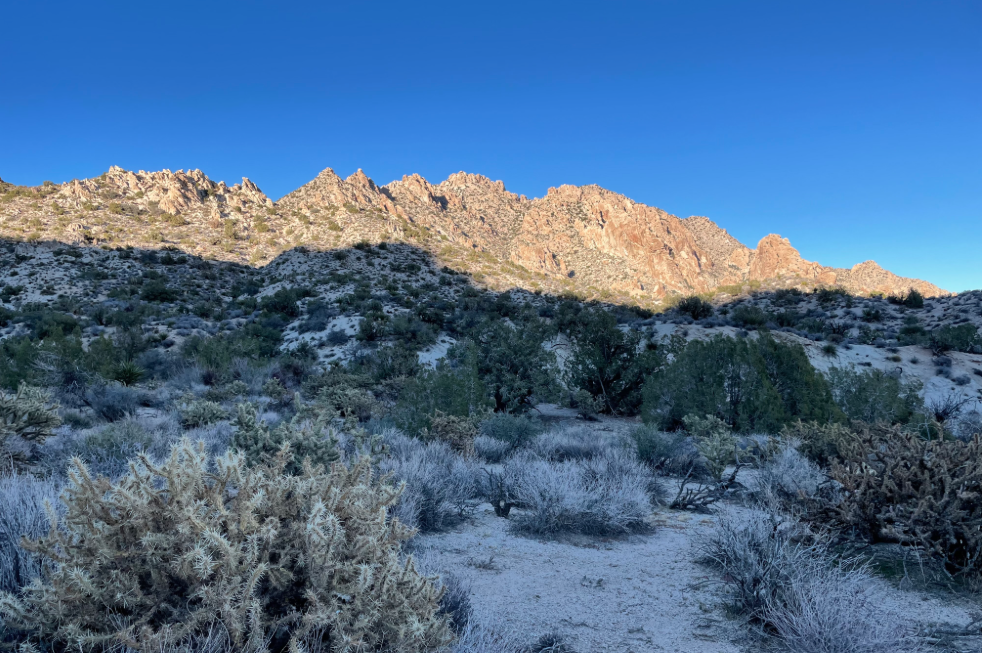
Spirit Mountain.
March 21, 2023 - SEARCHLIGHT, Nev.— Basin and Range Watch hailed the formation of a new national monument today, as President Biden signed the proclamation under his power using the Antiquities Act, designating Avi Kwa Ame National Monument.
The new park unit protects a diversity of Mojave Desert lands in the southern tip of Nevada, including Joshua tree woodlands, unique desert grasslands, natural cactus gardens, and cultural landscapes important to the Fort Mojave Paiute, Chemehuevi, and other Tribes along the Colorado River in California, Nevada, Arizona, and Utah.
Desert bighorn sheep inhabit the rocky ridges and mountains, while Mojave desert tortoises, Gila monsters and diamondback rattlesnakes occupy desert basins. The Joshua tree woodlands hold several bird species that are found nowhere else in Nevada, including gilded flickers, Harris’s hawks, and occasional curve-billed thrashers.
Basin and Range Watch petitioned the Bureau of Land Management to designate Avi Kwa Ame as an Area of Critical Environmental Concern in 2018, after multiple battles to fend off industrial-scale energy projects in the area. Western Watersheds Project and Basin and Range Watch also organized a Bioblitz in 2022 to help document the many species of desert plants and animals here.
The hills and broad valleys have come under threat of energy sprawl by both wind and solar project developers. A coalition of local residents and Basin and Range Watch sued the Bureau of Land Management to halt a giant wind project, and successfully prevented its construction on these sensitive habitats. In 2015 District Court Judge Miranda Du vacated the federal permits for construction of the Searchlight Wind Project in Southern Nevada. Judge Du found that environmental analyses prepared by the BLM and U.S. Fish & Wildlife Service inadequately evaluated the dangers that the industrial-scale wind project would pose to golden eagles, desert tortoises, and bats.
In 2015 a Swedish company submitted an application to BLM to construct another wind facility, the Crescent Peak Wind Project, on 33,000 acres of the Castle Mountains along the California/Nevada boundary and up to the border of the Wee Thump Joshua Tree Wilderness Area. This project would have been mostly within the National Monument boundary. A coalition of environmental groups, tribes, and hunters petitioned the Secretary of the Interior to protect these mountains for bighorn sheep, eagles, and visual resources. In 2018 the Interior Department issued a letter directing BLM to deny the application.
Yet the same developer returned with a new wind application on the Castle Mountains, calling it Kulning Wind Project. Objections voiced by tribes and conservation groups about conflicts with land preservation convinced BLM to place this project on a “low priority” status.”
Recently, Avantus (formerly 8minute Energy) sought to adjust the monument boundary to accommodate their proposed Angora Solar Project on 2,500 acres, most of which overlaps the boundary of the Monument.
In 2018, Basin and Range Watch wrote up a nomination to protect the area as the proposed Castle Mountains Area of Critical Environmental Concern, and gained a wide array of signatories to support the nomination to the Bureau of Land Management. We believe this helped to crystalize a new National Monument campaign in the area. See more >>here.
Lake Tamarisk: "Oasis in a Living Desert"
March 14, 2023 - Lake Tamarisk, CA - Desert community opposes utility-scale solar projects next to town.
Prepared by Candace Ryding, Long Time Resident of Lake Tamarisk
The Lake Tamarisk Community got it’s start when Kaiser Steel was in need of housing for their workers, shortly after World War II. The mine operated until early 1982. At that time the population of Lake Tamarisk began to change. See this community page >>here.
Tule Springs Fossil Beds National Monument Paleontological Resources May Block Controversial Greenlink West Transmission Project

^Columbian mammoths and sabertooth cat in spring wetlands at Tule Springs Fossil Beds National Monument, Nevada, Pleistocene. Drawing by Laura Cunningham, Copyright 2023.
March 8, 2023 - Las Vegas, NV - From Public Employees for Environmental Responsibility (PEER), with help from Basin and Range Watch:
Plans for a mega-transmission corridor in Nevada have hit a roadblock in the form of a survey showing that its route through a national park would likely destroy a trove of prehistoric fossils, according to the results of a ground-penetrating survey released today Public Employees for Environmental Responsibility (PEER). The survey of Tule Springs Fossil Beds National Monument found the strong likelihood of “vertebrate skeletal elements” in areas along the proposed right-of-way for the planned “Greenlink West” high-voltage system to transmit power from Las Vegas to Reno.
When Congress created the Tule Springs Fossil Beds National Monument in 2014 near Las Vegas to protect invaluable Ice Age paleontological discoveries, it also authorized a nearby electric transmission corridor (now called Greenlink) to carry “primarily… renewable energy resources.” In the intervening years, two things changed: 1) the Greenlink line corridor will serve natural gas facilities; and 2) it has been rerouted to cross the Monument.
More >>HERE.
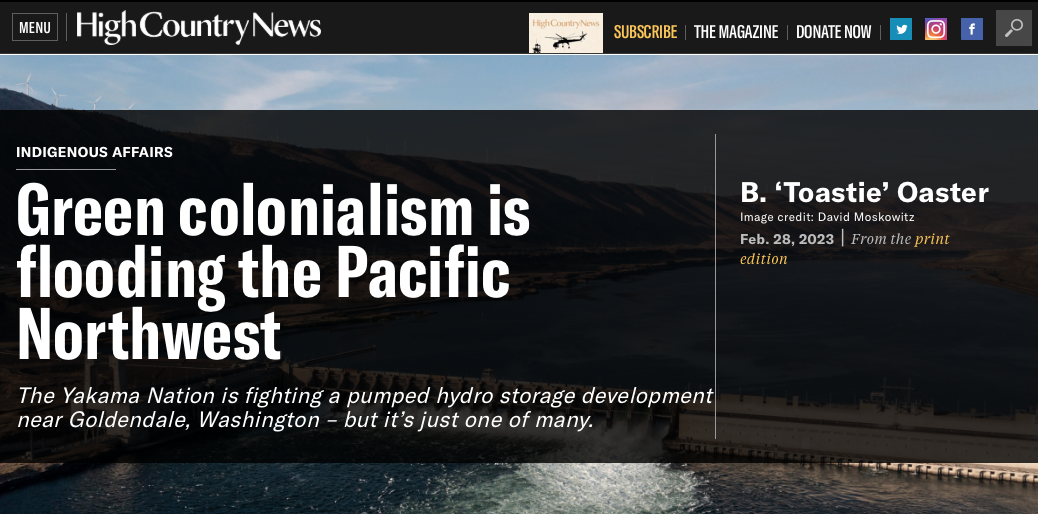
March 8, 2023 - Good article by High Country News on the flood of renewable energy projects into the Pacific Northwest. See the article here>> https://www.hcn.org/issues/55.3/indigenous-affairs-green-colonialism-is-flooding-the-pacific-northwest?utm_source=wcn1&utm_medium=email&utm_campaign=2023-02-28-Newsletter
Groups, Tribes Ask Appeals Court to Halt Nevada Lithium Mine
February 28, 2023 Reno NV - A federal judge last week refused to block the Thacker Pass mine from moving forward while appeals are heard. Red about it here: https://subscriber.politicopro.com/article/eenews/2023/02/28/greens-tribes-ask-appeals-court-to-halt-nevada-lithium-mine-00084699
2023 Solar Programmatic Environmental Impact Statement Update
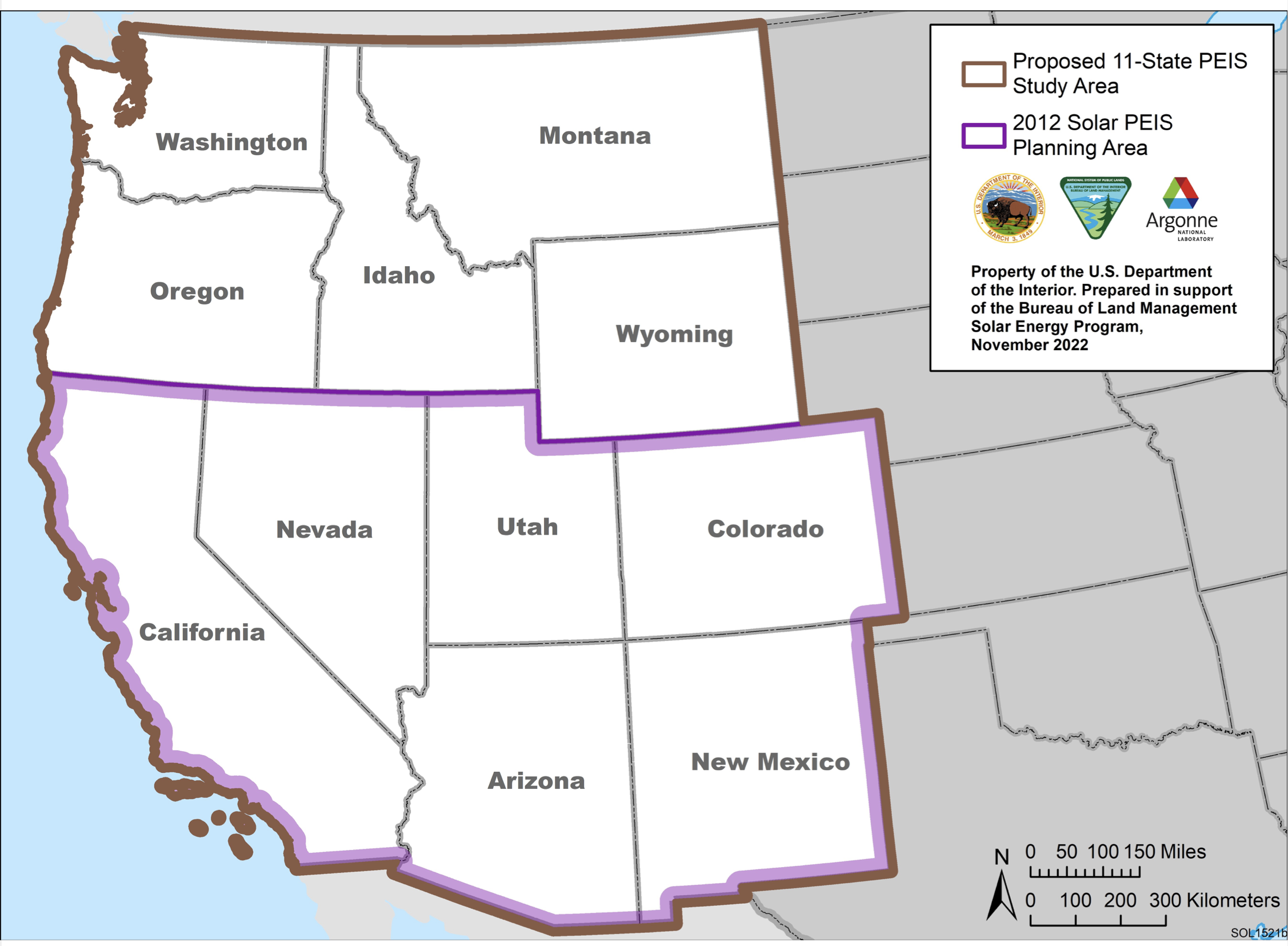
January 10, 2023 - The Bureau of Land Management (BLM) is developing an updated plan to guide solar energy development on public lands through an updated Solar Programmatic Environmental Impact Statement (Solar PEIS), which will "help accelerate and continue momentum for the clean energy econom" in a statement issued by BLM. The 2012 Solar PEIS will be expanded to all western states, opening up the vast sagebrush habitats to utility-scale solar development.
The comment deadline is February 6, 2023. Stay tuned, Basin and Range Watch will be writing extensive comments, and will provide summary points to write in your own public comments.
In California, the Desert Renewable Energy Conservation Plan (DRECP) may need to be updated as well in order to conform to the updated Solar PEIS which overlaps. We will be commenting on this.
Important links:
https://eplanning.blm.gov/eplanning-ui/project/2022371/570
Register for virtual meetings at https://www.blm.gov/2023-solar-programmatic-environmental-impact-statement
The Bureau of Land Management is holding a series of public scoping meetings to solicit feedback on the recently announced programmatic environmental impact statement for the BLM’s utility-scale solar energy planning. The BLM is considering updates to its 2012 Western Solar Plan that included six southwestern states—Arizona, California, Colorado, Nevada, New Mexico, and Utah—and is seeking comment regarding expanding its solar planning to include five additional states: Idaho, Montana, Oregon, Washington, and Wyoming. More >>here at our Solar PEIS page.
Prayers and Calls for Action at the Salton Sea
An Indigenous Peoples’ Day Vigil, Oct 10, 2022 at Desert Shores
Dispatch from the Heart of an Environmental and Social Justice Apocalypse
by Ruth Nolan, Mojave Desert Literary Laureate, October 20, 2022
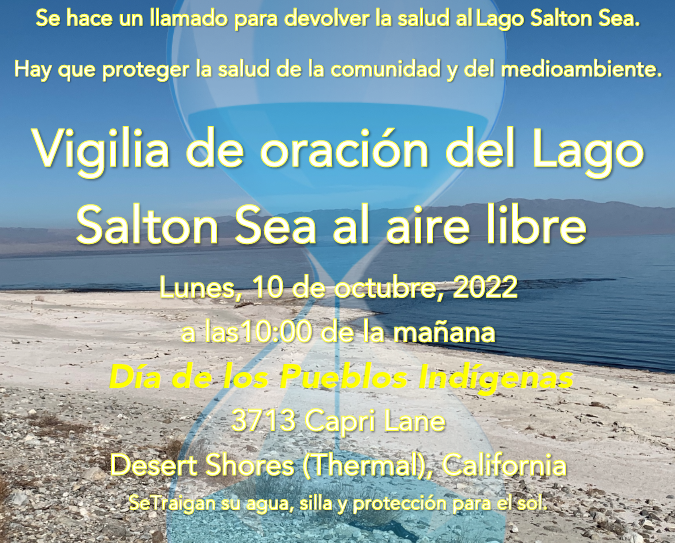
Not far from the iconic and uber-popular Joshua Tree National Park and even fewer miles from the world’s most fabled music festival, Coachella, a glaringly overshadowed dark side to the love affair with the desert: the Salton Sea. It hovers surrealistically below sea level in a huge basin in the middle of one of the hottest deserts in the world, in a neglected and little-known corner of southern California that borders Mexico, its waters shrinking daily at an alarming rate. See more >>here.
Basin & Range Watch Nominates a New Area of Critical Environmental Concern To Protect Tortoise and Springs
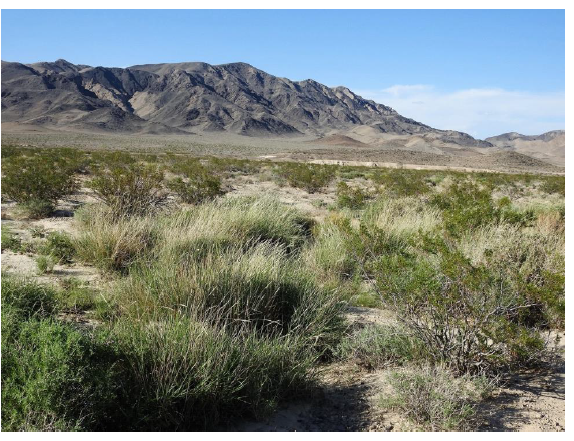
^Lush stands of big galleta grass make excellent Mojave desert tortoise habitat, but are threatened by utility-scale solar applications.
September 19, 2022, Indian Springs Valley NV - Basin & Range Watch and colleagues are nominating the Cactus Springs Area of Critical Environmental Concern (ACEC) in Clark and Nye Counties, Nevada, north of Indian Springs on Bureau of Land Management land, in order to protect rare plants, cactus diversity, Cactus Springs water resources, and the most significant Mojave desert tortoise connectivity corridor in southern Nevada. Read more here: Cactus Springs ACEC nomination.
See more at the proposed Bonanza Solar Project page.
Environmental Justice in the Desert
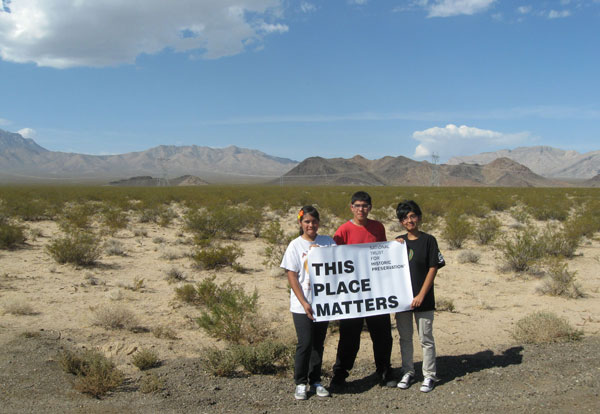
^Ivanpah Valley CA, Chemehuevi and Fort Mohave Paiute young people at the Spririt Run before the solar projects were built.
August 13, 2022 - Recently we have been accused of ignoring Environmental Justice, so we want to set the record straight and highlight our concern for these significant issues. Basin and Range Watch has worked for over a decade to listen to Indigenous voices, protect cultural landscapes, and help low income desert communities to have a voice and participate in the environmental review process for large-scale energy development on public lands surrounding them.
Here are some links with a focus on protecting local and low income communities, communities with people of color, and Tribes, that Basin and Range Watch has participated in over the years, and helped organize and fund (such as renting porta-potties for Indigenous-led Spirit Runs on public lands).
Blythe, CA, protests and Indigenous Spirit Runs to protect the deserts and cultural resources.
Cultural values and sacred sites threaetned by the Palen Solar Project.
Palen Solar Project letter by La Cuna de Aztlan Sacred Sites Protection Circle.
More >>here.
Coalition Letter on the Variance Process for Golden Currant Solar Project
August 9, 2022 - Pahrump NV - The proposed Golden Currant Solar Project is undergoing a Variance Review process and the Bureau of Land Management (BLM) has recently segregated mineral rights for 2 years to consider an application for a 4,300-acre solar project.
A coalition of conservation groups, including the Desert Tortoise Council, Mojave Green, Wildlands Defense, and individuals signed a letter by Basin & Range Watch, see the pdf here.
Under the 2012 Solar Programmatic Environmental Impact Statement, Variance Areas of public land outside the designated Solar Energy Zones include about 20 million acres where applications will be reviewed on a case-by-case basis. Options to combine federal and non-federal land will be looked at, as well as disturbed lands. Presence of conflicts, such as tortoise density, will also be considered. These applications will undergo public scoping. More >here.
Field Trip to Proposed Golden Currant Solar Project Site
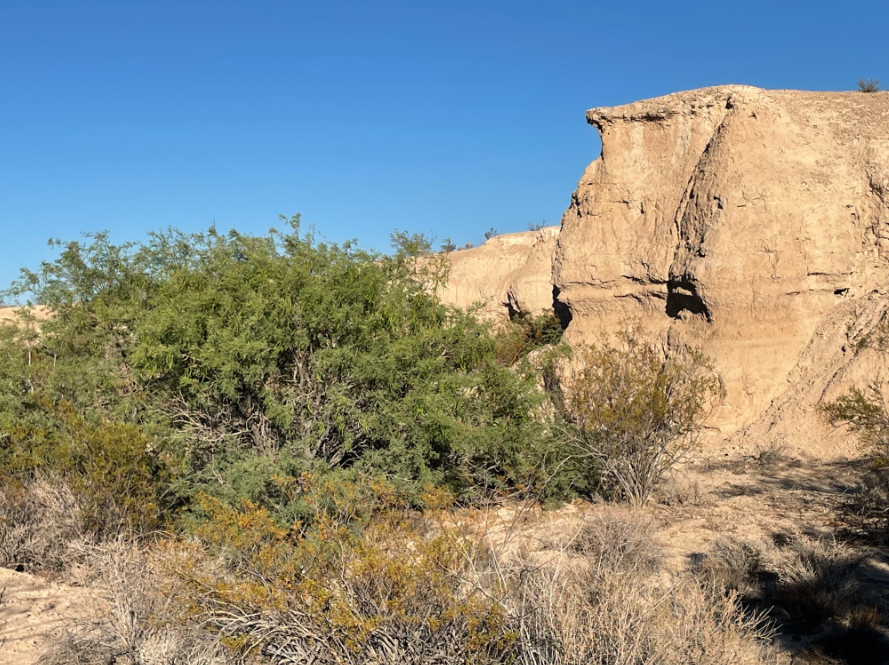
July 24, 2022 - Pahrump, NV - Basin & Range Watch undertook a field trip and site visit in early July, 2022, to the proposed Golden Currant Solar Project, along the Fornt Site Road off Tecopa Road. We were amazed at how 40-50% of the proposed project site is full of badlands with deep washes and vertical cliff topography--this is not a flat desert landscape. Also, honey mesquite thickets are common in the badland washes and interfluves. The other parts of the site have ancient desert soils and Mojave yuccas. Our photos are >>here.
Proposed Bonanza Solar Project on High Quality Mojave Desert Habitat
"The Most Critical Desert Tortoise Connectivity Corridor in Southern Nevada"
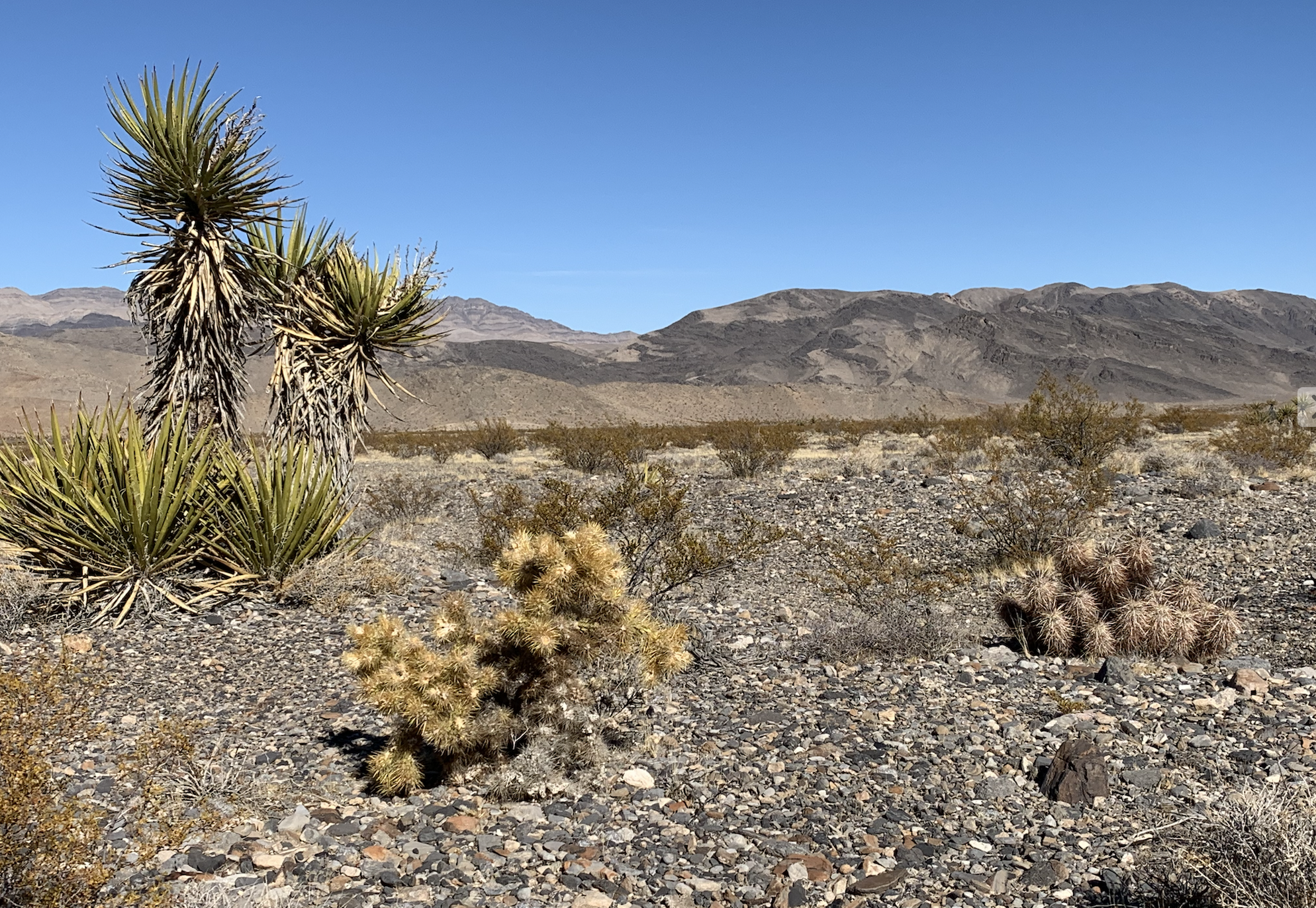
^The limestone fans here are habitat for a diversity of Mojave Desert succulents: Mojave yucca, silver cholla, and calico cactus.
June 18, 2020 - Las Vegas, NV - A large, over 2,000-acre, solar energy project is proposed to be built just north of Cactus Springs on land managed by the Bureau of Land Management (BLM) in Clark County, Nevada. The site is on the alluvial fans along the eastern side of the Spring Range. The project would harm fragile desert wildlife, remove thousands of desert plants like Mojave yuccas, impact the desert tortoise, destroy archeology sites, create dust, fence off public land, and be visually unsightly.
This is Mojave desert tortoise habitat, and once again as the species is heading towards extinction in the wild, the proposal to build the solar project anyway and translocate tortoises is being pushed.
Yet the agencies acknowledge there are impacts. From the Medium Priority letter whereby BLM determined this area has significant challenges associated with building a utility-scale solar project:
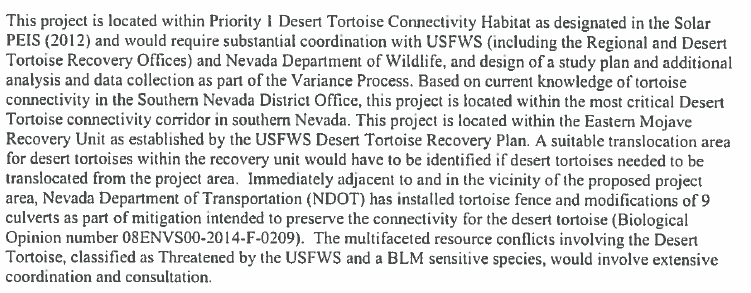
See more on the Bonaza Solar Project >>here.
Southern Nevada Renewable Energy Projects Update
June 9, 2022 - Las Vegas, NV - The Southern Nevada District of Bureau of Land Management released this slide deck in PDF form of a useful summary of all solar and wind applications in Clark County and Nye County south of Beatty. See the BLM Southern Nevada District Renewable Energy Program Update PDF.
Amargosa Valley Solar Projects
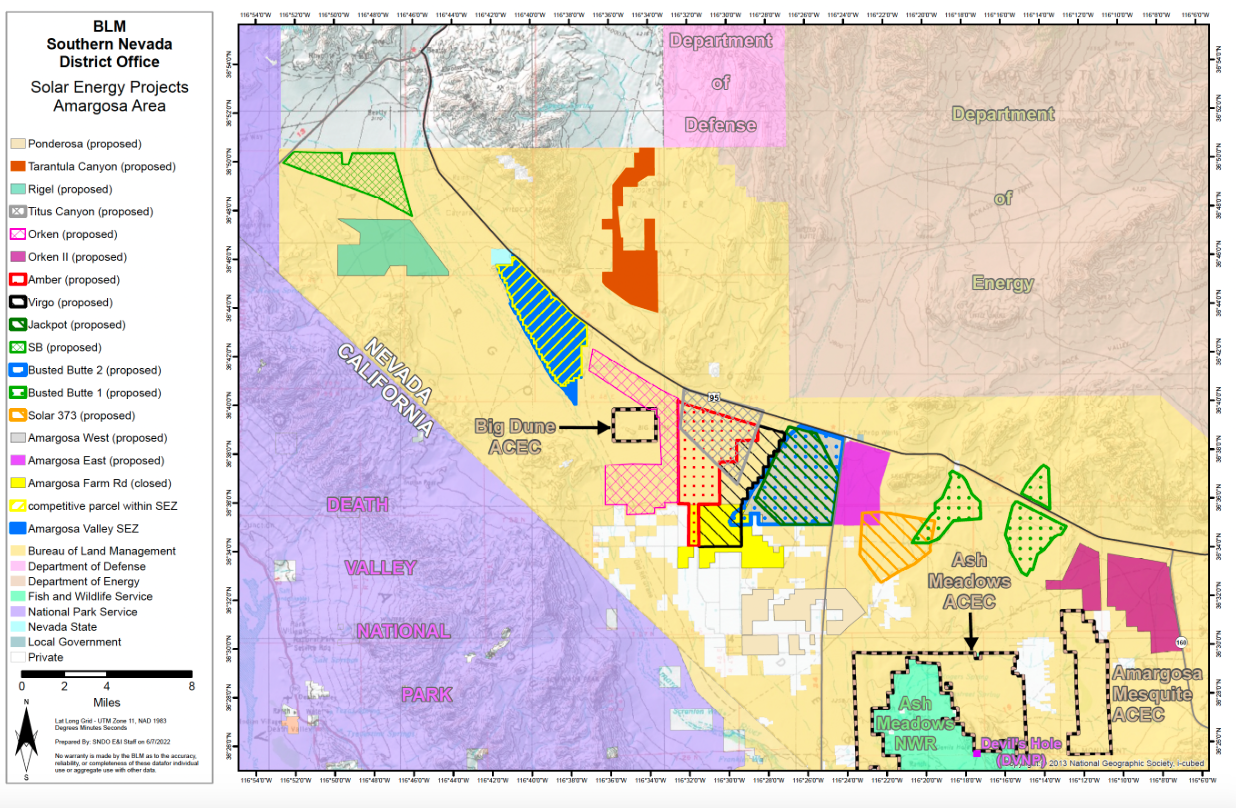
June 8, 2022 - Amargosa Valley, NV - The Bureau of Land Management Pahrump Field Office released a map showing the huge number of solar applications filling up, and overlapping, in Amargosa Valley public lands. The original Amargosa Solar Energy Zone was supposed to be the place for solar energy development here, but solar developers have taken advantage of loopholes in the Variance process where they can apply for public lands outside of the Solar Energy Zone and still profit. More >>here.
On a related note, you can comment on the Amargosa Solar Energy Zone leasing.
https://www.blm.gov/press-release/blm-seeks-comments-amargosa-valley-solar-energy-zone-leasing
Rough Hat Clark Solar Project Moves Forward
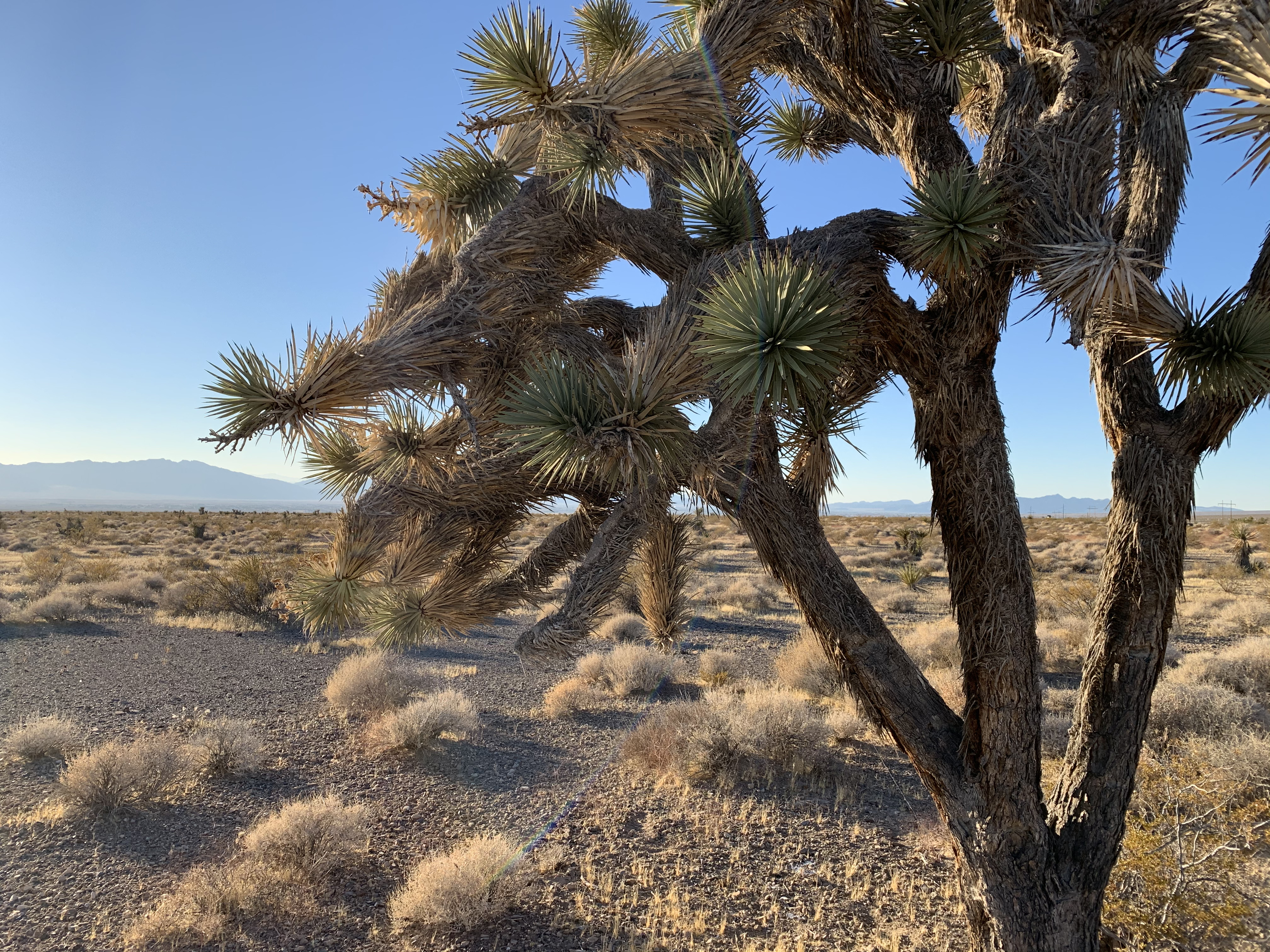
^Joshua tree on the proposed site of the Rough Hat Clark Solar Project.
June 7, 2022 - Pahrump, NV - The Bureau of Land Management (BLM) announced today that the 400-megawatt Rough Hat Clark Solar Project on 2,400 acres of public land just south of Pahrump, in Clark County, is moving forward in its application phase to an environmental review. Last winter BLM held a virtual Variance Process determination meeting, where the agency assessed whether this large-scale solar project should be allowed to be built outside of an established Solar Energy Zone. BLM determined that it could. Now BLM will prepare an Environmental Impact Statement and seek public comment.
We made several site visits to this alluvial fan, and it is high quality Mojave desert tortoise habitat and contains Joshua trees. Both can be moved out of the way of energy development. Recreational access will be cut off with 8-foot tall chainlink fences, and dust pollution will be a potential looming problem. Water will be needed to try to suppress dust during construction--where will that come from? The project is proposed for the west side of highway 160 close to the boundary of Nye County in south Pahrump Valley.
Stay tuned for more information as the scoping process begins for this utility-scale solar project by Candela Renewables, LLC--a company out of Spain. More on Rough Hat Clark and Rough Hat Nye solar projects >>here.
Here is the announcement: https://www.blm.gov/press-release/blm-advances-rough-hat-clark-county-solar-project-application
BLM ADVANCES ROUGH HAT CLARK COUNTY SOLAR PROJECT APPLICATION
LAS VEGAS – The BLM has completed the variance process for the Rough Hat Clark County Solar Project right-of-way application after coordination and consultation with appropriate federal, state, and local agencies and Tribes. After receiving public input, the BLM will initiate an environmental review of the project.
The Rough Hat Clark County Solar Project is a proposed 400 MW utility-scale photovoltaic solar power generation and battery storage facility on approximately 2,400 acres of BLM-managed public land located in the Pahrump Valley in Clark County, southeast of the Town of Pahrump and approximately 38 miles west of Las Vegas.
“After careful consideration, the BLM will continue processing the application and proceed with initiation of the National Environmental Policy Act process,” said Shonna Dooman, Las Vegas Field Office Manager. “Stakeholder engagement efforts by the BLM identified potential concerns and we will use this information during the environmental review for the Rough Hat Clark County Solar Project.”
The BLM hosted two virtual information forums in December 2021 to provide interested parties with a description of the application evaluation process, including the variance process, on the proposed project. The BLM provided opportunities for input from the public and federal, state, and local agencies, and initiated government to government consultation with Tribes, including conducting field trips.
The next step is to publish the Notice of Intent to Prepare an Environmental Impact Statement, which will kick off the public scoping process and comment period. Comments submitted during the initial evaluation will be further considered during the National Environmental Policy Act process for the project.
Proceeding with processing the Rough Hat Clark County Solar Project does not render project approval or otherwise entitle the applicant in any way, nor does it create any right or benefit, substantive or procedural, enforceable at law or equity by a party against the United States, its departments, agencies, instrumentalities or entities, its officers or employees, or any other person. The variance determination and supporting documentation, including the Input Summary Report, and additional information for the Rough Hat Clark County Solar Project can be found at https://eplanning.blm.gov/eplanning-ui/project/2019992/510.
The BLM manages vast stretches of public lands that have the potential to make significant contributions to the nation’s renewable energy portfolio. To promote the development of these energy sources, the BLM provides sites for environmentally sound development of renewable energy on public lands. The efficient deployment of renewable energy from our nation’s public lands is crucial in achieving the Biden-Harris administration’s goal of a carbon pollution-free power sector by 2035, as well as Congress’ direction in the Energy Act of 2020 to permit 25 gigawatts of solar, wind, and geothermal production on public lands no later than 2025.
Bureau of Land Management Moves Several Solar Projects by Death Valley to Low Priority
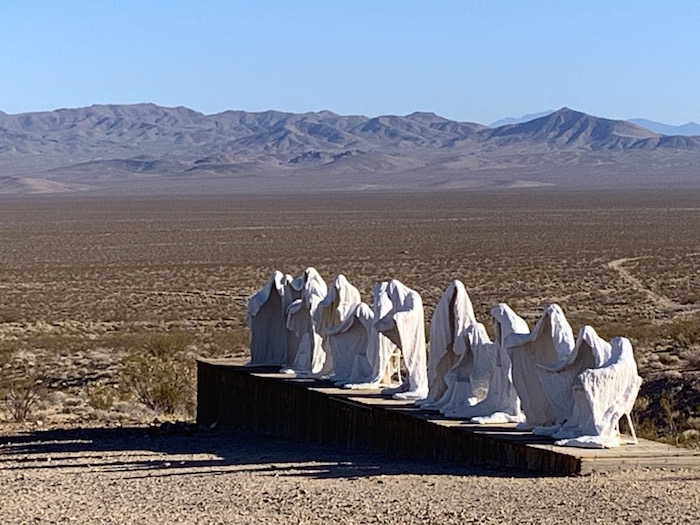
^NextEra Energy is proposing to build a large utilit-scale solar project right here in upper Amargosa Valley, in view of the Goldwell Open Air Museum and ghost town of Rhyolite. The Beatty Energy Center is the project application name. The Furnace Creek Range lies in the distance, in Death Valley National Park.
May 26, 2022 - Beatty, NV - At the request of the residents of the region working through their town, letters were sent to the Bureau of Land Management (BLM) Tonopah Field Office requesting the Beatty Energy Center application, Sawtooth Solar Project application, and Bonnie Claire Solar Project application be moved to Low Priority Status. We received the confirming letters from the BLM that this was done. More >>here.
Solar Projects Planned Near Death Valley Would Hurt Wildlife, Public Access and the Local Economy
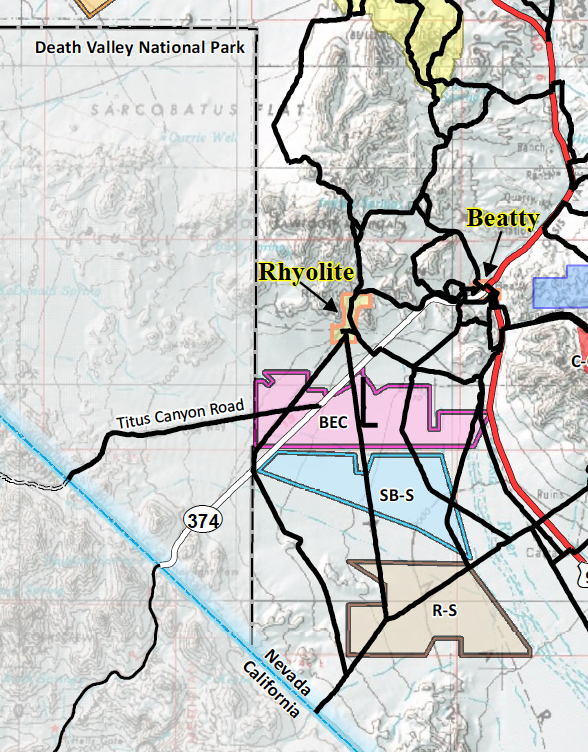
^Detail of map produced by the Town of Beatty showing solar project applications around Beatty, the ghost town of Rhyolite, and the Titus Canyon entrance road.
March 17, 2022 - A new land rush of large-scale solar project proposals have been filed for nearly 60,000 acres of public lands so far adjacent to Death Valley National Park in Nevada.
Two good articles came out recently concerning the many very large utility-scale solar projects in Nevada public lands on the east side of Death Valley National Park, next to Wilderness Areas in the park. These applications are enabled by the proposed Greenlink West Transmission Project that NV Energy is seeking to ship natural gas power generation from the Apex, NV area northwards to the energy-intensive "Silicon Valley" facilities of Reno/Sparks, NV--the Tesla Gigafactory, Amazon wharehouse, Google facility, Blockchain and others.
Good coverage by Scott Streater of E&E News:
https://www.eenews.net/articles/solar-boom-casts-shadow-on-death-valley-national-park/
Good local coverage by Scott King of the Sierra Nevada Ally:
https://www.sierranevadaally.org/2022/03/14/a-land-rush-for-renewable-energy/
Much more here >>here, including maps and descriptions of the solar applications.
Lithium Boom Across California and Nevada
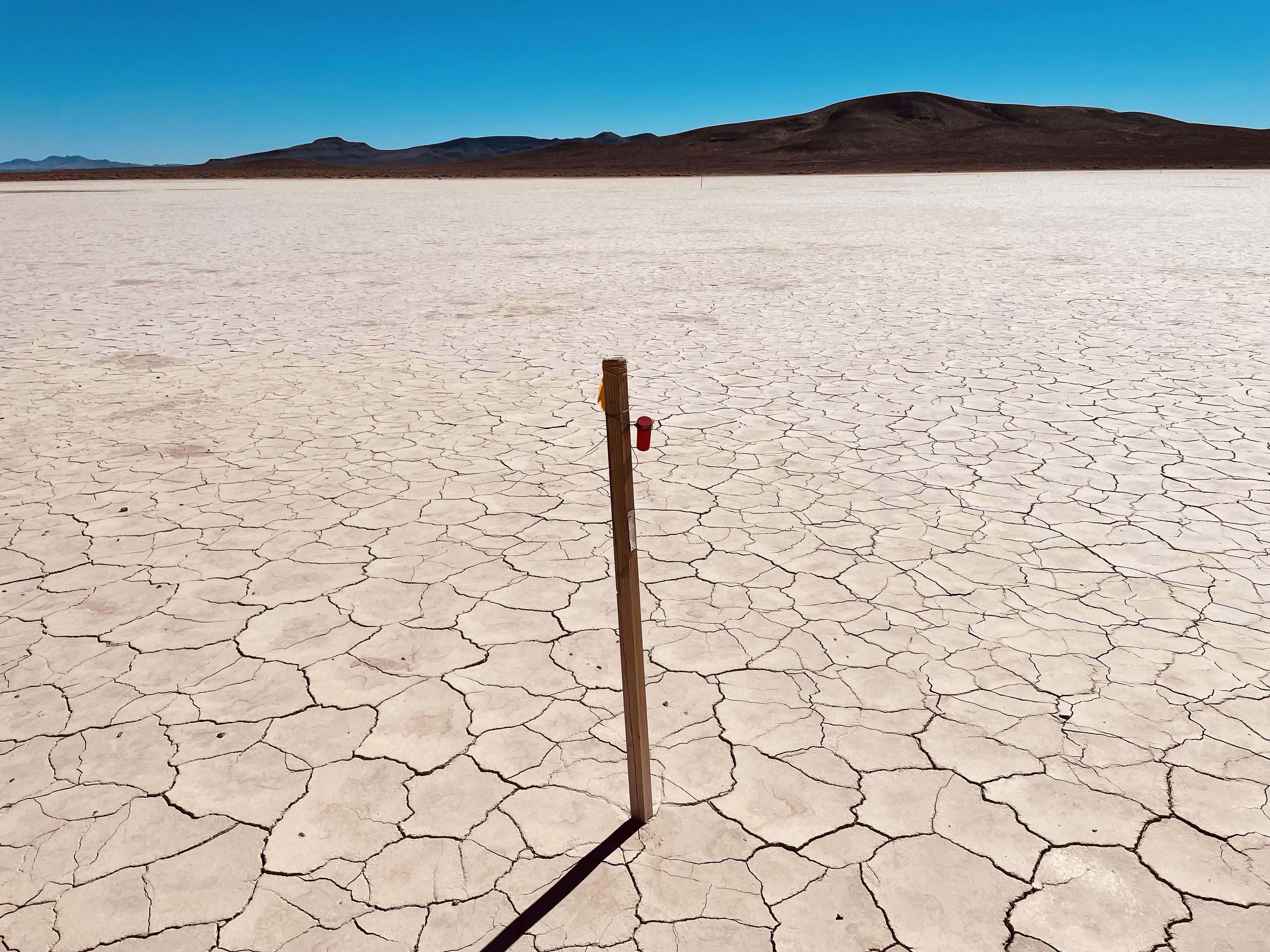
^Lithium claim stake on a playa in Sarcobatus Flat, NV, east of Death Valley National Park.
February 22, 2022 - An "ion rush" is currently underway in arid lands of southern California and Nevada as miners literally stake claim markers on playas and open deserts east of Death Valley National park in Nevada. Similarly, the Biden Administration on February 22 announced large investments in so-called "critical minerals" such as Lithium, cobalt, and rare earth minerals used in renewable energy manufacture, batteries, and electric vehicles.
The White House Fact Sheet announced that outdated mining laws and regulations will be updated. This year, the Mining Law of 1872 turns 150. This law still governs mining of most critical minerals on federal public lands. Today, the Department of Interior (DOI) announced it has established an Interagency Working Group (IWG) that will lead an Administration effort on legislative and regulatory reform of mine permitting and oversight. The IWG released a list of Biden-Harris Administration fundamental principles for mining reform to promote responsible mining under strong social, environmental, and labor standards that avoids the historic injustice that too many mining operations have left behind. The IWG will deliver recommendations to Congress by November. They will also host extensive public input and comment sessions to ensure an inclusive process, and will work with the relevant agencies to initiate updates to mining regulations by the end of the calendar year. More >> here.
Solar Leasing on Public Lands
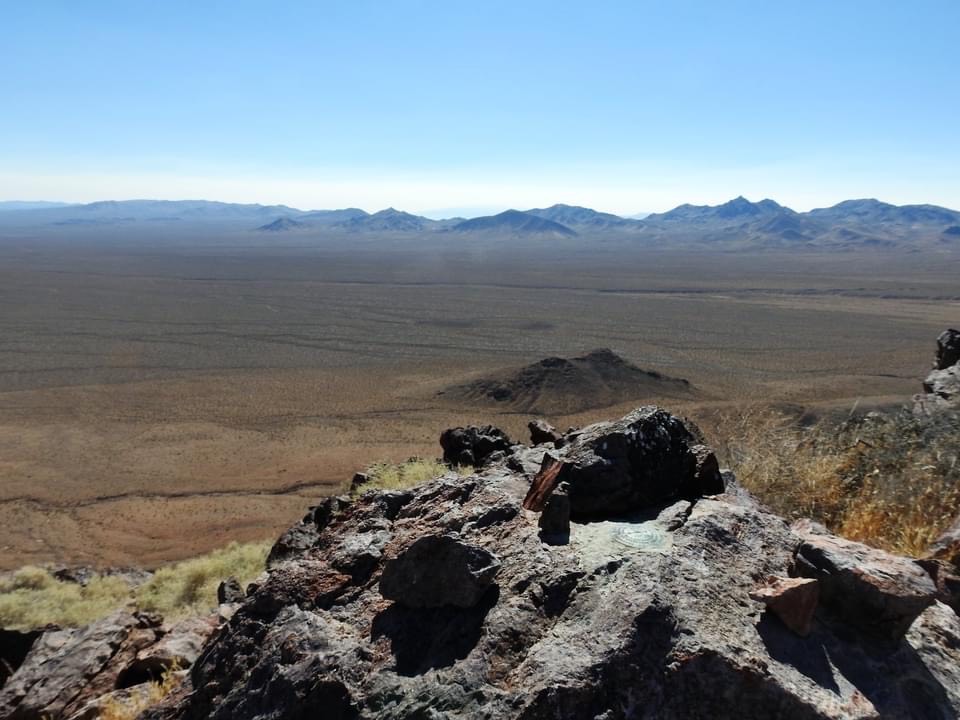
^Northern Amargosa Valley, Nevada, along the east side of Death Valley National Park, proposed for thousands of acres of utility-scale solar development.
February 14, 2022 - Washington, D.C. – The Bureau of Land Management (BLM) is seeking public input on draft guidance to promote the use of wind and solar energy on public lands. The proposed update would reduce acreage rental rates and capacity fees for existing and new wind and solar energy authorizations on public lands. Once finalized, the updated guidance will provide enhanced financial and regulatory predictability for solar and wind energy projects authorized on public lands.
“This draft guidance will help us drive an environmentally and economically sound strategy in the development of renewable energy resources on public lands.” said BLM Director Tracy Stone-Manning. “We are doing our part to meet America’s energy needs by promoting predictable and favorable conditions for the market.”
See the announcement here: https://www.blm.gov/press-release/blm-seeks-public-input-proposed-guidance-renewable-energy-blm-public-lands?fbclid=IwAR0euvTgUNq5Oe2icS65fCVYqrZuOqh3aOwyl3MBcWPzdXFFKLwkEFkgJjU
The trouble is, favoring the market over biodiversity and public lands access for all doe not mesh. The Biden Administration is not driving environmentally sound renewable energy development on public lands, especially in places like Nevada, where Mojave desert tortoises are imperiled, and thousands of old-growth yuccas and Joshua trees are slated to be bulldozed down and mulched to make way for photovoltaic projects that would better go ion rooftops and over parking lots in the built environment.
Our comment sent in:
February 2nd, 2022
To: Bureau of Land Management
Email sent to: energy@blm.gov
Re: Comments on proposed guidance for Renewable Energy on Public Lands
Basin and Range Watch is a 501(c)(3) non-profit working to conserve the deserts of Nevada and California and to educate the public about the diversity of life, culture, and history of the ecosystems and wild lands of the desert.
The Bureau of Land Management is seeking public input on draft guidance to promote the use of wind and solar energy on public lands. The proposed update would reduce acreage rental rates and capacity fees for existing and new wind and solar energy authorizations on public lands.
The Federal Land Policy and Management Act of 1976 (FLPMA) provides that right-ofway holders must generally pay fair market value for their use of the use of public lands. (Section 504(g) of FLPMA authorizes the Secretary to collect less than fair market value in certain narrow circumstances. The statute provides that no rental fees shall be collected for rights-of-way for electric or telephone facilities eligible for financing under the Rural Electrification Act of 1936. Additionally, the Secretary has discretion under section 504(g) to authorize rights-of-way at less than fair market value to: a Federal, State, or local government or any agency or instrumentality thereof, to nonprofit associations or nonprofit corporations which are not themselves controlled or owned by profitmaking corporations or business enterprises, or to a holder where he provides without or at reduced charges a valuable benefit to the public or to the programs of the Secretary concerned, or to a holder in connection with the authorized use or occupancy of Federal land for which the United States is already receiving compensation.)
The Energy Act of 2020, 43 U.S.C. 3003, provides the Secretary of the Interior with authority to reduce acreage rental rates and megawatt capacity fees if, among other things, the Secretary determines “that a reduced rental rate or capacity fee is necessary to promote the greatest use of wind and solar energy resources.”
We think it is irresponsible and frivolous to reduce fair market value fees on public lands for renewable energy developers. This will set unfavorable precedents and future administrations will use this tactic to streamline oil and gas leasing, mining and other development on public lands.
Not only would this set precedents, it will increase the negative environmental and cultural impacts that large-scale renewable energy inflicts upon public lands. We see that this Interior Department has a clear agenda to place environmental concerns behind the agenda of these large-scale developers.
The Federal Land Policy and Management Act states: “public lands be managed in a manner that will protect the quality of scientific, scenic, historical, ecological, environmental, air and atmospheric, water resource, and archeological values; that, where appropriate, will preserve and protect certain public lands in their natural condition; that will provide food and habitat for fish and wildlife and domestic animals; and that will provide for outdoor recreation and human occupancy and use;” (The Federal Land Policy and Management Act of 1976 as amended [blm.gov])
Large-scale green energy has massive space requirements and is inconsistent with most of the FLPMA conservation guidelines.
Instead of reducing rental rates for large-scale renewable energy developers on public lands, we would like to see the rates increased in order to compensate for the grave environmental damage inflicted by many of these projects.
We recommend increasing rental rates and fees for the use of multiple-use public lands, especially high-value lands which are rich in species diversity, significant cultural landscapes, and natural and cultural resources.
Utility-scale solar, wind, geothermal, and transmission projects have significant impacts to public lands resources that need to be accounted for, and that have not been adequately mitigated, avoided, or offset.
To incentivize renewable energy development on public lands with even less fees amounts to a public subsidy by taxpayers of large-scale energy development. This subsidy should instead go towards incentivizing Distributed Energy resources in the built environment, including aiding low-income communities to reach renewable energy goals.
Some of the many impacts of utility-scale renewable energy projects on high-value public lands include:
- Renewable energy development releases large stores of soil and vegetation Carbon.
- Visual Resources are greatly impaired by large-scale solar, wind, and associated transmission projects.
- Site preparation and maintenance of solar fields significantly impacts vegetation communities and rare plants, as well as pollinators.
- Dark night skies are impacted
- Public access, recreation, and local tourism economies are heavily impacted by large-scale renewable energy leases.
- Air quality, dust, and valley fever increase happen with renewable energy development on undisturbed ecosystems.
- Groundwater pumping can be significant with associated construction and maintenance of renewable energy facilities.
- Surface hydrology is often severely impacted by large solar projects.
- Sand-transport corridors are often blocked by utility-scale solar projects.
- Unique geological and paleontological resources are often destroyed or impaired.
- Invasive weeds are spread into intact ecosystems, and herbicide applications can harm native species.
- Imperiled species like the federally threatened Mojave desert tortoise continue to decline towards extinction, and mitigation and compensation measures for current renewable energy development are not working to halt this decline or recover the species.
- Sensitive species like the Mojave fringe-toed lizard, flat-tailed horned lizard, Gila monster, burrowing owl, sage-grouse, Mohave ground squirrel, and desert kit fox are threatened with population declines by the current build-out of renewable energy.
- Wildlife connectivity corridors are blocked by large-scale energy projects.
- Archaeological resources are often damaged, cultural landscapes impacted, and tribal concerns ignored.
Again, we recommend that rents and fees for the private corporate use of public lands not be lowered, but should be raised to account for the significant costs associated with large-scale development of high-value ecosystems, natural and cultural resources, and loss of recreation and access.
100 Square Miles of Solar on Public Lands: Esmeralda County, Nevada, Solar Applications
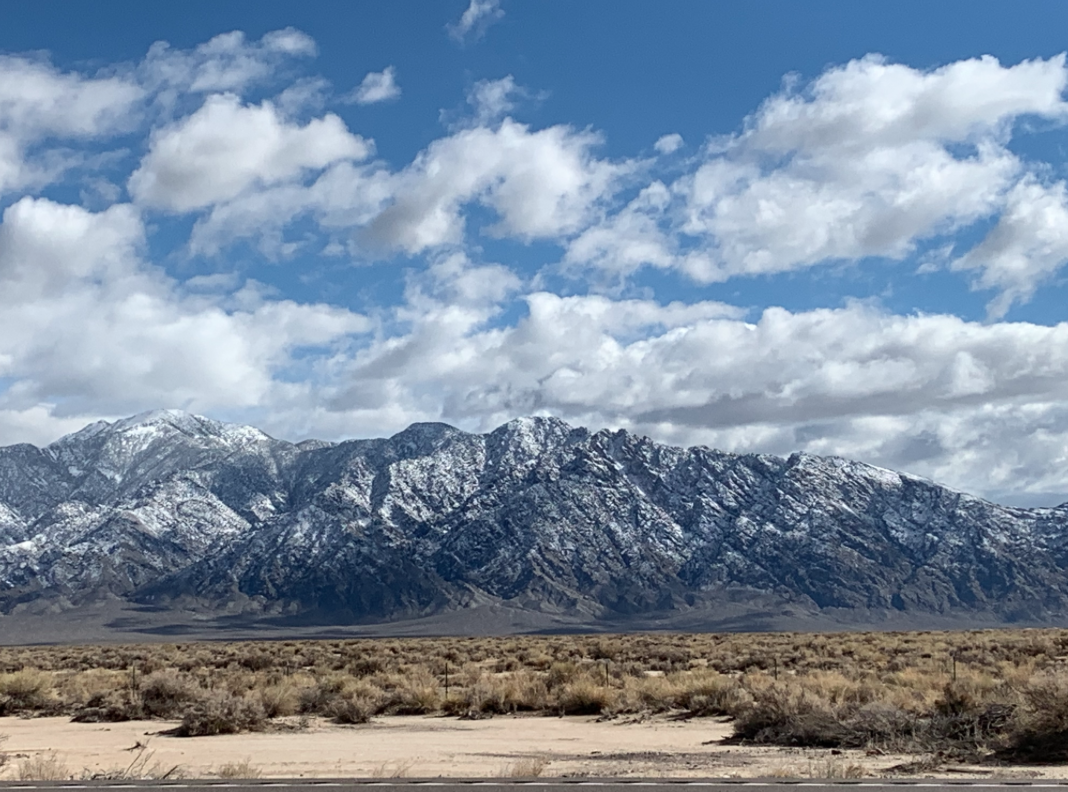
^Lone Mountain with snow, March 2019, Nye County, Nevada, with utility-scale solar projects proposed for the basin just below.
September 1, 2021 - Tonopah, Nye County, NV - Various solar developers are scurrying to place applications for very large photovoltaic solar projects on public lands in the Great Basin, in the latest solar gold rush to mark territory along the proposed high-voltage Greenlink West Transmission Project. If this 525 kiloVolt long transmission line were to be built, it would open up nearly every basin in southwestern Nevada from Reno to Las Vegas to large-scale solar energy project development.
So far the applications amount to approximately 63,000 acres--nearly 100 square miles of solar development!
Basin and Range Watch toured the area today along with filmmaker Justin McAffee, despite the heavy smoke flowing from the Caldor Fire and other California wildfires--which raises the question: with so many hundreds of thousands of acres of Sierran and Cascade habitats going up in flames, do we need to destroy more desert habitat for industrial energy projects, when solar panels can very easily go on already-disturbed lands, and onto rooftops and over parking lots? With climate change looming, we need to preserve every last acre of intact, healthy native plant communities and wildlife habitat, including these undisturbed Nevada basins.
^A core Pronghorn antelope herd area exists in this basin. We saw a herd of antelope on our tour of the proposed solar development application area today, at the far southern end of Big Smoky Valley. Solar projects would impact these antelope. Photo by Kevin Emmerich.
Here is the press release from Bureau of Land Management in full, which we distributed far and wide throughout our grassroots network, since BLM failed to notice this widely to the public and local communities which would be effected (we noted that after repeated calls today by Basin and Range Watch for more information, and threats of Freedom of Information Act requests, BLM has updated this page today to include links to Plans of Development for most of these solar projects--we attempt to include these links, but please visit the original BLM press release page if links do not work; we also are archiving these PDFs because we have noticed renewable energy documents disappearing over the years from government websites):
Basin and Range Watch Co-Founder Interview
November 14, 2020 - KNPR in Nevada interviews Kevin Emmerich on his vision for defending the desert. A must read!
Yellow Pine Solar Project Approved and New De Facto Solar Energy Zone in South Pahrump Valley
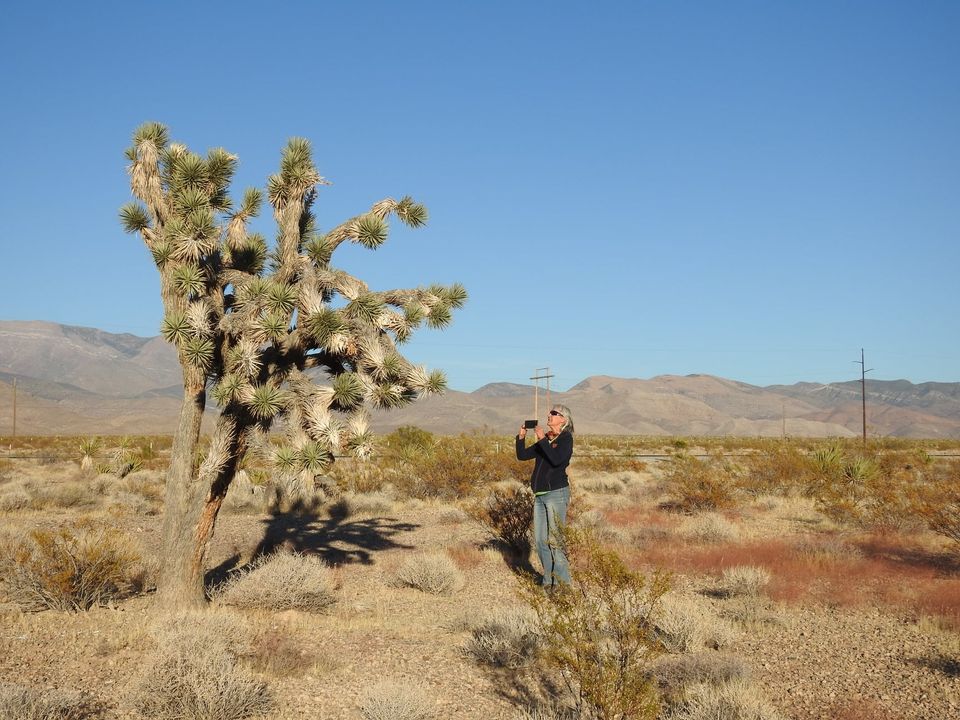
November 6, 2020 - Pahrump NV - The Bureau of Land Management approved the Yellow Pine Solar Project On November 6, 2020. Impacts to desert tortoise, over 80,000 Mojave yuccas, desert pavement and old soil crust will not be adequately mitigated. Basin and Range Watch will appeal the decision.
But several new applications surrounding the Yellow Pine project, on equally pristine Mojave Desert, call into question the entire process of the Solar Programmatic environmental review of years ago where solar developers were supposed to be incentived to build in supposedly lower value Solar Energy Zones. No Solar Energy Zone exists in Pahrump Valley, yet developers are flocking here because of the availability of existing high-voltage transmission lines. More >>here.
Our Magazine of the Desert: El Paisano Continued!
December 23, 2018 -- It's finally here! Our newsletter of the desert. As an all-volunteer group we slowly developed this continuation of the venerable El Paisano, which dates back to 1955, as published by the Desert Protective Council (DPC). DPC gave us permission to continue to publish this newsletter.
Download the 6.5 MB PDF of El Paisano December 2018 (Vol.1 No. 1)
Here is a summary of El Paisano by Jim Styles in The Canyon Country Zephyr, 2014:
"The DPC began to publish the El Paisano in the Spring of 1955. In these fascinating 1950s quarterly volumes, the reader learns that the founders and members of the fledgling organization hit the ground running, immediately forming issues committees, informing themselves about issues related to their particular interest and taking action on controversial plans for the desert across Arizona, California, Nevada and Utah.
"There apparently was no scarcity of ill-advised proposals for the desert even in the 1950s. Early newsletters document the political savvy and lack of timidity of the early Board and advisory panel members. Some of the problems DPC tackled in the early years, such as the threat from uranium mining in Joshua Tree and the battle to save the Grand Canyon from a dam, have been solved, but a plethora of new threats to the desert have arisen that could not have been conceived of in the 1950s. The onslaught of bad ideas for the use of our deserts has increased with the growing human population of the southwest. Exploitation of the desert for minerals and desert ground water, military expansion, poaching, rampant resort development, industrialization by massive energy projects and transmission lines, new freeways and the proliferation of off-road vehicles continue to fragment desert habitats."
Stay tuned for more issues of El Paisano. We may make this a quarterly magazine, possibly with print and digital versions in the future. For now this will be a downloadable PDF digital magazine.
Thank you for your support to help us publish this! We are honored to continueEl Paisano.
`
Calendar of Comment Deadlines:
Greenlink West Transmission Line Project Draft Envirommental Impact Statement deadline August 23 for public comments >>BLM
GridLiance West Core UpgradesTransmission Line Project Scoping deadline September 7 for public comments >>BLM
Golden Currant Solar Project in S outh Pahrump Valley Nevada Scoping comments deadline June 9 >>BLM
Bonanza Solar Project in Clark County Nevada is moving forward >>BLM
Solar applications on east side of Death Valley National Park in pre-NEPA stages
Rough Hat Nye Solar Project, Nevada-in Variance Process, pre-NEPA-stay tuned!
Rough Hat Clark Solar Project, Nevada-in Variance Process, pre-NEPA-stay tuned!
Copper Rays Solar Project, Nevada-in Varance Process, pre-NEPA-stay tuned!
Sign up for our Email Newsletter! >>here
Cactus Springs ACEC Nomination
Poorly Sited Solar, Wind, and Storage Projects on Public Lands
Environmental Justice in the Desert
Public Lands and Renewable Energy
Natural History of the Desert and Great Basin
Clark County, Nevada, Lands Bill
Giving Thanks to the People who have lived and live in these Deserts for thousands of years. We live today on the unceded homelands of the Shoshone, Paiute, Chemehuevi, and many many more Tribes and Indigenous Peoples.
“You've got to get people to believe that change is possible... You have to show that you can fight things successfully even if you don't win.”
-- Winona LaDuke
“What our Seventh Generation will have is a consequence of our actions today.”
-- Winona LaDuke
"True wealth is not measured in money or status or power. It is measured in the legacy we leave behind for those we love and those we inspire."
--Cesar Chavez
"In the first place you can't see anything from a car; you've got to get out of the goddamned contraption and walk, better yet crawl, on hands and knees, over the sandstone and through the thornbush and cactus. When traces of blood begin to mark your trail you'll see something, maybe."
--Edward Abbey, 1967, Desert Solitaire
"Polite conversationalists leave no mark, save the scar upon the earth that could have been prevented had they stood their ground."
--David Brower
"Only within the 20th Century has biological thought been focused on ecology, or the relation of the living creature to its environment. Awareness of ecological relationships is — or should be — the basis of modern conservation programs, for it is useless to attempt to preserve a living species unless the kind of land or water it requires is also preserved."
--Rachel Carson, Essay on the Biological Sciences, in Good Reading (1958)

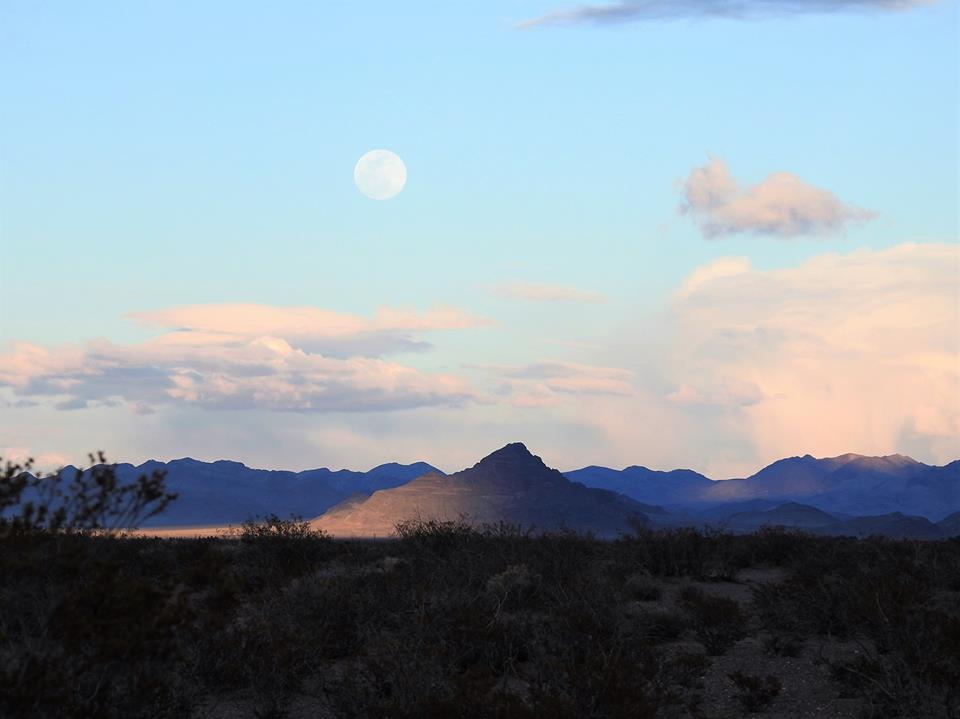
^Amargosa Valley view from near Longstreet, Nevada.



